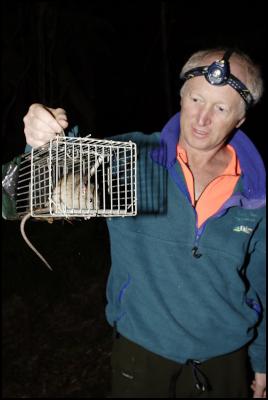Pest-free exclosure more prison than paradise
Pest-free exclosure more prison than paradise
for rats

Research in which rats were released into a pest-free area has shown they pose less of a threat than first thought.
Ship rats fitted with transmitters were released into a 65 hectare area on Maungatautari near Cambridge during April to September. The area is surrounded by a pest exclusion fence that keeps mammalian predators out, but not in. Once the entire mountain is made pest-free, the area will become part of a 3400 hectare sanctuary planned by the Maungatautari Ecological Island Trust. Landcare Research scientists aimed to find out how rats would behave if they invaded the area, to help design the best defence systems.
Six male rats were caught near the perimeter fence and released inside the sanctuary, one at a time. Only male rats were selected, to prevent breeding.
Four rats climbed back out over the fence, two within 24 hours. The remaining two stayed close to the release point for 3 days, often running around the top of the fence. They then wandered over increasing distances inside the cell. Both were eventually poisoned (after 8 and 28 days).
Landcare Research scientist John Innes says the sanctuary was not exactly a candy store for the rats.
“We thought they would be busting to get in, because there’s ample food and no predators, and that once they did get in, they’d be hard to catch, and do a great deal of damage.
“But in fact, the rats apparently did not want to be there. They would have had to find new den sites and feeding places, and they had no social contacts.”
Mr Innes says although the fences are effective, pests can still invade via trees falling over near the fence, floods or vandalism. However, the research has turned up several key findings for sanctuary managers to combat any rat-related risk.
“We recommend that the Trust place traps on the rim of the fence top as well as inside the exclosure. Also, the knowledge that any rats invading the exclosure first linger within scent of home provides a window of opportunity to catch them when they first arrive.
“After 3 days rats move quite large distances, much larger than their usual territorial range. This is an important clue as to how rats behave at low population densities.
“Given the large distances they cover, male and female rats in that situation could probably find each other quite easily and establish a new population, so it really is important to catch them early.”
Maungatautari Ecological Island Trust Chief Executive Jim Mylchreest says the information gained is of vital importance in managing the project, as it provides factual information to establish the search area and ship rat detection techniques required after a fence breach occurs.
ENDS


 Hugh Grant: How To Build Confidence In The Data You Collect
Hugh Grant: How To Build Confidence In The Data You Collect Tourism Industry Aotearoa: TRENZ 2026 Set To Rediscover Auckland As It Farewells Rotorua - The Birthplace Of Tourism
Tourism Industry Aotearoa: TRENZ 2026 Set To Rediscover Auckland As It Farewells Rotorua - The Birthplace Of Tourism NIWA: Students Representing New Zealand At The ‘Olympics Of Science Fairs’ Forging Pathway For International Recognition
NIWA: Students Representing New Zealand At The ‘Olympics Of Science Fairs’ Forging Pathway For International Recognition Coalition to End Big Dairy: Activists Protest NZ National Dairy Industry Awards Again
Coalition to End Big Dairy: Activists Protest NZ National Dairy Industry Awards Again Infoblox: Dancing With Scammers - The Telegram Tango Investigation
Infoblox: Dancing With Scammers - The Telegram Tango Investigation Consumer NZ: This Mother’s Day, Give The Gift Of Scam Protection And Digital Confidence
Consumer NZ: This Mother’s Day, Give The Gift Of Scam Protection And Digital Confidence